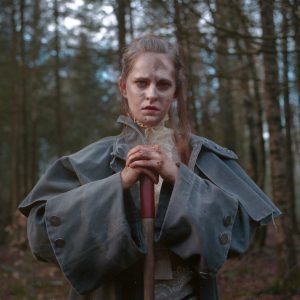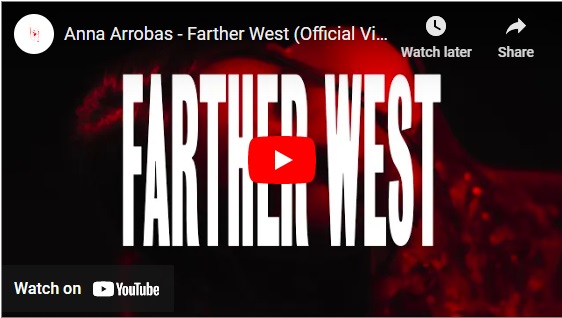 Made to Touch, singer-songwriter Anna Arrobas’ debut album, was one of the hidden treasures of the musical landscape of Québec in the Fall of 2022. Her delicate voice, her soft and intoxicating tunes, coated with shoegaze guitars, subtly augmented by acoustic tones and studied orchestration, make it a small gem of ethereal pop. Yet the artist herself envisioned her album as “minimalist folk with country influences”!
Made to Touch, singer-songwriter Anna Arrobas’ debut album, was one of the hidden treasures of the musical landscape of Québec in the Fall of 2022. Her delicate voice, her soft and intoxicating tunes, coated with shoegaze guitars, subtly augmented by acoustic tones and studied orchestration, make it a small gem of ethereal pop. Yet the artist herself envisioned her album as “minimalist folk with country influences”!
“While I was collaborating with Pierre [Guérineau], Jesse [Osbourne-Lanthier] and Asaël [Richard-Robitaille], the album became this grandiose and cinematic thing that was radically different from what I imagined,” says Arrobas.
But before we dive into the music, let’s take a moment to study the project’s mysterious cover art. Anna poses, looking exhausted and downcast, while her face is smeared, and wounds are visible on her hands, which rest on the handle of what appears to be a shovel. She’s in the middle of a forest, dressed in what looks like vestments from a bygone era. One can imagine the scene as follows: December 1837, the day after the battle of Saint-Eustache, a defeated patriot buries her dead.
“I love how you read it!” exclaims Arrobas. “I’m really fascinated by this kind of universe. I like to imagine myself travelling in time to worlds like that” – which also evoke the gothic, supernatural decor of Tim Burton’s Sleepy Hollow (1999). “I did want to create something ambiguous, that would prompt people to wonder during what era the picture was taken.”
Arrobas is, first and foremost, a professional photographer, explaining the attention and care she devoted to the cover art – and if you flip the vinyl version of said sleeve, what you’ll see on the back cover is a hole in the ground. “I really like to work with images that have a cinematic dimension, and tell a story, because there’s a lot of storytelling in my lyrics,” she says. “I wanted to describe a scene where even if you don’t quite understand what’s going on, you get the pain and the severity of the moment.”
Arrobas has been writing songs since the age of 16, encouraged by her dad Jérémie, who was the keyboardist in the first incarnation of famous synth-pop band Men Without Hats. “When I’m composing, I can’t say specifically what the story or the subject of a song will be until I start writing,” says Arrobas. “It’s while I’m writing that I understand what story it’s telling, it’s internal logic, and what I experienced that inspired it. In the end, it always relates to something I’ve lived.
“I’m someone who ruminates a lot about my life and all the little decisions I’ve made,” she continues. “I accept it all, but yeah, I analyze everything that happens in my life a lot. [On Made to Touch] I talk a lot about loss, and thinking about my past, and how everything could have been different, and how I want to just bury and forget everything. I talk a lot about love, heartbreak, losing someone – even thinking about losing a lover before he’s actually left you. Take “Farther West,” for example: the song is told from the point of view of a woman whose husband has gone off to war knowing he won’t return.”
In 2019, Arrobas released a debut EP, mixed by Pierre Guérineau (Feu St-Antoine, Essaie Pas) and mastered by Jesse Osbourne-Lanthier. During the summer of 2020, the pair of musicians and producers founded the record company Éditions Appærent, a formidable pool of avant-garde musical talent that Arrobas joined while working on her debut — which was extensively fine-tuned during the pandemic, with the contribution of another partner of the label, Asaël Richard-Robitaille. Like Guérineau, they’re also a member of Marie Davidson’s band, and l’Oeil Nu.
“They’re truly talented musicians and producers,” says Arrobas. “I’m lucky I got to collaborate with them. I didn’t know them that well when we met. We talked about the music we love – we all adore Cocteau Twins, Prefab Sprout, The Jesus and Mary Chain, stuff we discovered in our youth.” The specific influence of Cocteau Twins, and the more general influence of the heyday of their label, 4AD, in the ’80s, can clearly be heard on Made to Touch.
“We mostly share interest in a wide variety of music and it was clear, while we were making the album, that we didn’t want to get pigeonholed in one style,” says Arrobas. That explains why the album also explores ambient music (particularly on “Careworn Seal”), adding a lot of texture and atmosphere to the whole thing; in fact, one of Jesse Osborne-Lanthier’s specialties is the attention to such sonic detail.
“We also found out we all love playing videogames!” says Arrobas. “We’re all fans of original videogame music, and the first time I met Jesse wasn’t even in person. We were online playing Animal Crossing!”
